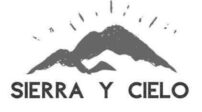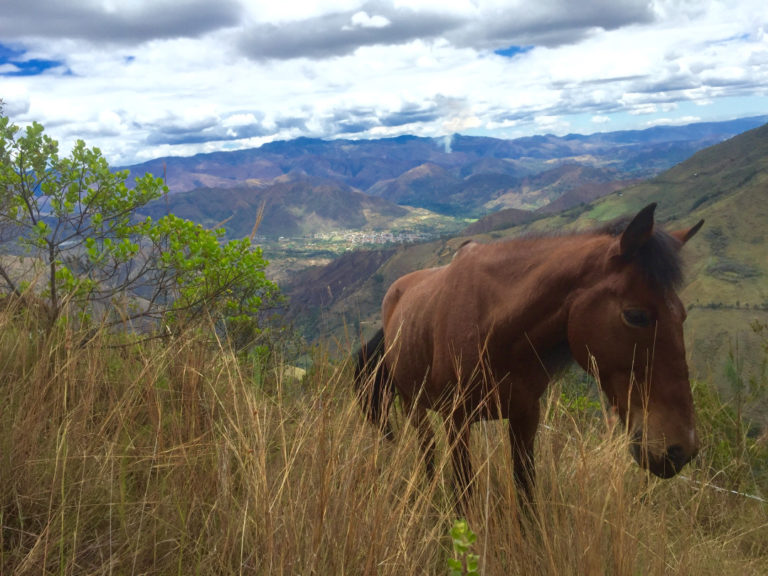Last post, I focused on goats as a great example of how herbivores can regenerate the land, through holistic management techniques, but they aren’t the only ones within our agroecology. We also have horses, and sometimes also work with donkeys in a similar pasture rotation system, often on their own, but sometimes sharing pastures with the goats, depending on the type of vegetation available. Because our equine friends are grazers, the predominant vegetation is low to the ground, making it easier to lay fencing without having to clear a lot of brush that would be grounding the electric fence. It’s also easier because they only require one strand of tape to contain them, compared to the two that barely keep those capricious goats in.
A major drawback to grazers here, though, is that the mountain’s ecological succession does not favor grasslands. In fact, I heard that many of the grasses common in the region today, were actually introduced in the seventies. None of them are in any way invasive. Within a few years, shrubs, cactuses and vines begin to take over. The grasses initially appreciate the respite from full rays of low latitude, high altitude sun, and the desiccating punches of wind during the dry seasons, and the richer, more fungal soil ecology doesn’t hurt. But by around a decade later, shade is just too much for the grasses, and scrubland dominates, preparing the environment for the next level of succession, on the way towards the lower cloud forest similar to the borders of the national park, a couple hours’ hike up the mountain. That’s the goal for most of Sacred Sueños, but obviously not for our edible savannah, nor the pastures.
For the goats, the scrubland is an ideal environment, and one that would last decades, if free from human interference. For horses, though, it’s not always great. It seems cows are even more particular. At least the horses and donkeys I’ve worked with would follow the goats example when together, and eventually learn which shrubs were fine to eat. I’d actually planned to rotate all the hoofs together, but eventually the horses would just eat the most delicious tips of grass, then opt for the goats’ favorites rather than finish mowing.
 The hills surrounding Vilcabamba were often macheted frequently, but now that labor costs have risen (not a bad thing in of itself) ranchers either spray with toxic chemicals or light the mountain on fire regularly in order to return the ecosystem to something more favorable for their cattle, the almost exclusive income generators for those lands. With horses and donkeys, assisted by targeted goat pressure, our grasslands are more diverse, and consist of less work wasted fighting the forces of nature.
The hills surrounding Vilcabamba were often macheted frequently, but now that labor costs have risen (not a bad thing in of itself) ranchers either spray with toxic chemicals or light the mountain on fire regularly in order to return the ecosystem to something more favorable for their cattle, the almost exclusive income generators for those lands. With horses and donkeys, assisted by targeted goat pressure, our grasslands are more diverse, and consist of less work wasted fighting the forces of nature.
Less work isn’t no work, though. I’m still obligated to do the rounds with a machete about a dozen hours each month. I spend more time than that, picking up a portion of their weekly poop.
Equines aren’t ruminants, like cows, sheep, and goats. Ruminants have a much more complicated digestive system, including the rumen, which is a fermentation vat full of bacteria, fungi, and other microbes. With an such an efficient ecology doing most of the digesting, the ruminant spends much of their time just regurgitating and chewing up fibrous material to produce more surface area for those microbes to eat.
 Equines don’t have rumens, so they’re unable to break down most of what they eat. So while the goats spend much of their day looking at the view, ruminating wisely, the horses are mowing the mountainside nearly incessantly. For as much as 20 hours a day, they can be focused mainly on eating, and most of what goes in comes out the butt barely digested. I pick up a wheelbarrow of this concentration of grass clippings, and poop inoculated by a plethora of bacteria. The red wriggler worms really enjoy the mix of food and bedding.
Equines don’t have rumens, so they’re unable to break down most of what they eat. So while the goats spend much of their day looking at the view, ruminating wisely, the horses are mowing the mountainside nearly incessantly. For as much as 20 hours a day, they can be focused mainly on eating, and most of what goes in comes out the butt barely digested. I pick up a wheelbarrow of this concentration of grass clippings, and poop inoculated by a plethora of bacteria. The red wriggler worms really enjoy the mix of food and bedding.
It’s sad that poop is a polluting waste product in so many designs, when it could be a valuable resource if designed with ecology as a guide.
I value my equine friends for much more than their poop. In the industrial world, horses are valued as a luxury, a privilege of a wealthy few, but here they are an inexpensive necessity. It’s about an hours’ hike up a narrow trail, rising 700m (2300 ft). And the folks within the rest of Sacred Sueños are even further and higher! Horses and donkeys are essential for carrying materials, food, and sometimes even us, up and down between here and town.
While they may be a necessity because of our remoteness, I admit that I consciously chose a location that was remote. It wasn’t just a con that was worth accepting for pros like pure spring water and a fantastic view. The remoteness itself actually made it on the pro column during my land hunting days. Not having a road leading up to our home has meant not worrying about noise, privacy, and possible disputes. It nurtures our inner introvert.
I also consider living off road a way to challenge the social forces of unnecessary materialism. Our homes here stay humble, built predominantly of materials extracted from the land. Though our lifestyle is richer in food, freedom, and happiness than most on the planet, our ecological footprint is well below what our planet could sustain if everyone lived similarly.
And along with humble homes, not having cars has contributed greatly towards having a realistically sustainable ecological footprint.
Before I continue, I should note that I don’t judge anybody for having a car. We use taxis often to get from town to the trailhead, as well as between Vilcabamba and the city, Loja. And when I’m hitchhiking or with friends, I’m extremely grateful that my rides happen to have a vehicle. It’s up to each of us to decide what to do with our lives, and I’m not interested in telling anybody what they should be doing with theirs (unless they ask me).
And if anybody asks me if it’s ok to have a car as long as it’s electric or hybrid, I would tell them that the ecological footprint of making those new cars, and especially of those short lived batteries, is massive, even if the electricity came from a renewable source, which it almost never does. Even with combustion propelled vehicles, since the manufacture of a car has usually as much impact as the amount of fuel used in it’s lifetime, it’s easier on the planet if you just keep driving your old gas guzzler rather than falling for the greenwash marketing, and buying a new fuel efficient machine.

But the ideal vehicle for moving me and my stuff, has been a good steed. They might not have speed, but they can move through versatile terrain. Instead of needing expensive fueling, they mow lawns and refuel on the landscapes that they traverse. Instead of smog, they produce worm compost. I know how to make more of them without depending on several industries to provide them and in-debt me for their use. And I appreciate their autonomy more than I trust any self driving car.

